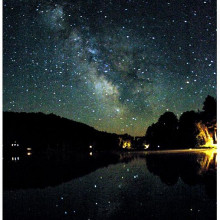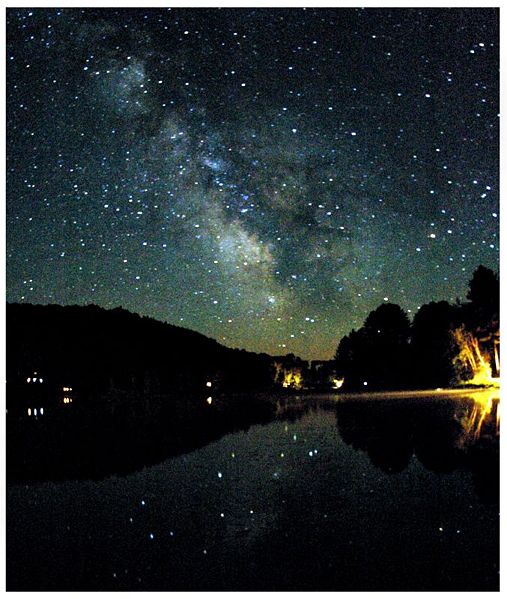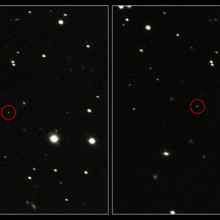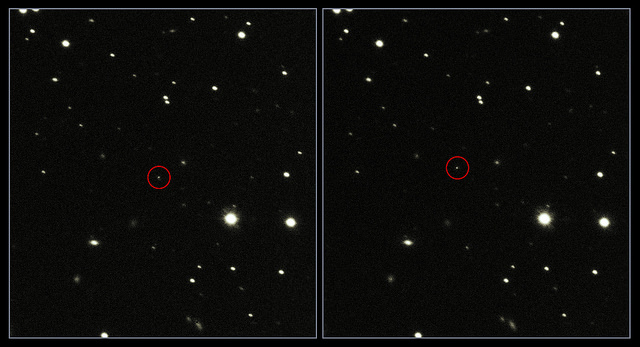Gaia launched back in 2013 and has been mapping the Milky Way ever since. In fact, it aims to give us the most detailed survey of our galaxy, ever. But is that all its set to do? Graihagh Jackson explores why scientists are going gaga over Gaia...
In this episode
01:14 - A guide to Gaia
A guide to Gaia
with Anna Hourihane and Gerry Gilmore, The University of Cambridge, George Seabroke, University College London, Duncan Forgan, St Andres University
Where's it going? And what's it doing? Here's a whistlestop tour of the probe with  Graihagh Jackson...
Graihagh Jackson...
Graihagh - It's a probe - a bit bigger than those round trampolines every family seems to have in their back gardens these days - and you can think of it as being shaped like one of those floppy straw hats- a large rim with a bulbous centre.
Anna - Yeah it's on a very defined orbit actually.
Graihagh - Anna Hourihane...
Annie - And it's on a position known as the second lagrangian point, which is a kind of stable point in the Earth/Sun gravitational system. And it actually orbits not around the Earth, but it stays outside of the Earth and kind of keeps pace with the Earth in it's orbit around the Sun.
Graihagh - Okay. So it's kind of orbiting somewhere in between Earth and Mars then/
Anna - Exactly, yes.
Graihagh - And it's taking lots and lots and lots of photos of the stars because...
Gerry - The key parameter for Gaia is where the stars are.
Graihagh - That's Gerry Gilmore. He pitched the idea of Gaia to the European Space Agency and has been shepherding along the project ever since.
Gerry - You'd think the history of astronomy - people have been trying to measure where the stars are since the Mesopotamians. Actually, astronomers are not very good at this sort of thing and so, in the whole history of science we had reasonably accurate measurements of the positions and distances from us of about maybe a hundred thousand stars and how those stars were moving. Out of a hundred billion that's pretty pitiful really and they're all very local.
The reason for that is that space is big so it's really hard to measure the distances of stars. You need exquisite precision which Gaia provides. So Gaia is the first ever exquisite measuring system which is designed to measure not only where stars are. A large sample one per cent of them all - a billion or so but, also, how those stars are moving. So we get three dimensions in space of where the stars are.
Graihagh - And last month, the released the first data set.
Good morning ladies and gentlemen and welcome to the European Space Astronomy Centre (ESAC) here in Madrid. Today is an important day and a great day for astronomy because we are releasing the first batch of our data set from our Gaia mission. My name is Markus Bohrer, I am head of the communications office in ESAC and it's really a pleasure for me to welcome you here on site but also welcome to all those of you who are watching us on YouTube.
Graihagh - And scientists have been so excited about it all, that some have turned to the arts. Here's a poem that George Seabroke wrote - astronomer from the Mullard Space Science Labs.
Twinkle, twinkle little star,
How I wonder where you are,
ESA hovers up your light,
With our Gaia satellite.
The mission is to measure distance,
Get a grasp on your existence,
Gaia may not see you twinkle,
But kens if you're multiple or single.
Astronomers we feel the need,
To measure line of sight speed,
Gaia's radial velocity spectrometer,
Is the Milky Way's speedometer.
The Mullard Science Laboratory,
Has helped to write the Gaia story,
Has tested every key detector,
And coded software for billions of spectra.
Graihagh - Gaia has been making waves throughout astronomy. Although, I have to admit, when I was trawling through ideas for this episode, I emailed Duncan Forgan, astrophysicist at St Andrews for advice and he replied....
Duncan - I think if I can recall correctly, I think I just said oh there's one word for you and that's Gaia, and it's the one mission that every astronomer is excited about. And I think that's possibly the first mission since I started doing astronomy professionally, which has been almost ten years. And it's the first time I could really feel one mission really grasped everybody's attention. I think the only other thing that's really done that in all the time that I've known is Hubble, so it's on that level.
Graihagh - Erm, after that sort of response, how could I not start looking into it. Although, I did check, Duncan's not just doing an excellent PR job.
Duncan - I have no formal official connection to Gaia but I think every astronomer feels informally connected to Gaia because it's such an exciting mission.
Graihagh - Why is it such an exciting mission - you're a bit tantalising glimpse there?
Duncan - Well, it's so exciting because it's doing things on a scale that, when the mission was conceived twenty odd years ago, we didn't think was even possible. And we have what's going to be a huge data set, not just of many, many stars in the sky. So at the end of the survey it will be a billion stars, which is one percent of all the stars in the Milky Way, which makes it sound like a small number but it's still a huge number. And we'll not only just have that but we'll have a lot of information about asteroids in the solar system.
We'll even start and use this method to detect planets around some of these stars. So it's a huge data set for people who are interested in all kinds of different aspects of astronomy from the solar system to the stars themselves, to planets around other stars, and then to the galaxy itself, so how those stars actually fit into the galactic structure.
Graihagh - Bit mission then - not a small amount of data that they're collecting?
Duncan - It's a huge amount of data. So we have the first data release, or DR1, has just landed this week and that's still a huge data set, and it's only a small parcel of what's going to be a number of releases over five years. So even just that very small release itself is quite a lot to deal with.

07:16 - How to map the Milky Way
How to map the Milky Way
with Anna Hourihane, University of Cambridge
Surprisingly, scientists are using GCSE maths to figure out where the stars are in our galaxy. Anna Hourihane put Graihagh Jackson through her paces...
our galaxy. Anna Hourihane put Graihagh Jackson through her paces...
Graihagh - Anna - I'm going to have to ask you how you pronounce your second name because when I can in here at reception I was like Anna Hari-hane, Hower-hane?
Anna - Almost - Harra-hen.
Graihagh - Have other people called you all sorts of really funny surnames? I'm just thinking Graihagh - I get a lot of these things.
Anna - Yes, I actually wasn't sure how to pronounce your name either at first? But my last name it can also be pronounced Hourahan, so depending on which part of Ireland you're from, so I'm used to different pronunciations and it doesn't bother me too much.
Graihagh - Thank goodness for that! Let's jump in - why do we want to measure the distance between stars and how do we do it?
Anna - Well, one thing that we don't know very well are distances to the stars and that's because they're very difficult to measure in astronomy. So Gaia's goal is to get accurate distancing for a very large sample of stars in our galaxy, actually more than one billion stars.
Graihagh - One billion - wow!
Anna - Yeah, so it's still less than probably one percent of the total stellar content of our galaxy but it will be the largest sample we have so far of accurate distances and it will be fundamental to lots of other areas of astronomy as well.
Graihagh - I'm just thinking - Gaia's got to have some incredible accuracy on it to be able to map, even if it is just one percent of the galaxy?
Anna - Yeah, the actual precision needed for the measurements is equivalent to resolving say a pound coin on the moon if you measured it from Earth. It needs very, very precise measurements to be able to measure these tiny movements that translate in being able to measure distances to stars.
Graihagh - How is it measuring where the stars are?
Anna - Well, it has two telescopes on board and collects light through two viewing windows in the satellite housing. So the starlight comes in through those viewing windows and passes through the telescopes and then gets focused onto a camera inside Gaia. So they're kind of continually transiting across the camera almost like a continuous video of the sky.
Graihagh - A bit like a time-lapse I'm thinking or something like that?
Anna - Yes exactly - it's like a time-lapse. And that data then gets down linked to Earth every day from the satellite.
Graihagh - And it was on the fourteenth of September that all this data was released. It was the first Gaia release of data.
Anna - Yes. The data that was released on the fourteenth of September was coming from almost the first year of observations by Gaia. And that's the first big release of data that is really useful to see how everything is going with the data processing and checking the quality of the data. The precision of the data is probably only about one tenth of what we will get at the end of the mission.
Graihagh - And that's because it's going to map these stars lots of times?
Anna - Exactly, yes.
Graihagh - And when we say data and things transiting across the camera - this data release was it pictures or was it numbers? I'm trying to envisage what was released.
Anna - No, we don't get pretty pictures like the Hubble space telescope images that we're used to seeing. With Gaia it's more about very precise measurements. So the raw data in terms of the times of transit of the stars across the camera and then the brightness of each star as measured.
Graihagh - Once you have this time code, if you like, and how bright this star is - how does that then enable you to measure how far away it is?
Anna - Well, there's a lot of complex mathematics involved but you can simplify it down into the concept of measuring distances by parallax. Parallax is the effect of the apparent change in the position of an object depending on which angle you view it from.
So, as a demonstration, why don't you hold out your thumb at arm's length.
Graihagh - It will have to be left thumb okay.
Anna - So now close your left eye and look at it with your right eye and notice the background behind your thumb. And then switch eyes closing your right and looking at it with your left and do you notice how the apparent position of your thumb appears to change against the backgrounds?
Graihagh - Yeah - it moves by about an inch or so.
Anna - Okay. Now bring your thumb closer, so about halfway, and try the experiment again. Do you notice anything different about the change in position?
Graihagh - It moves further.
Anna - Exactly. So by measuring the change in position of an object, say a star, against a background, we can figure out how far away the star is. And the parallels in this with thumb experiment are imagining that your thumb is a foreground star so a star that's closer to us, and the background is a backdrop of more distant stars. So you can see how one star appears to move against more distant stars. And, in this case, instead of the distance between your two eyes you're looking at the foreground star from two distant positions in the Earth's orbit around the Sun.
Graihagh - Ah, okay. I thought you were going to say the two telescopes but no, that makes more sense, two different positions around the Sun.
Anna - Exactly.
Graihagh - Okay - you've Gaia orbiting and capturing snaps from the stars at different angles. But then you've also got to take into consideration that the stars are also moving.
Anna - Yes well, actually, like the Earth and the other planets orbit around the Sun, the stars in our galaxy all orbit around the centre of the galaxy as well. But the motions of the stars around the centre of the galaxy, what that translates to in what we can observe is, over time, a slow track - kind of straight line of the stars across the sky. And over Gaia's lifetime, over the five years or more that it's observing, it will cause the stars to move a small distance across the sky. But then, when we combine that with the apparent motion due to the Earth's and Gaia's orbit around the Sun,that introduces kind of an ellipse into the motion.
Graihagh - It sounds quite complicated then to look at their distance and stuff?
Anna - Yeah, so quite complex algorithms, quite complex software, has had to be developed. But it actually relates back to basic trigonometry where if you have an angle, for example in the experiment where you're looking at the star or you're looking at your thumb with your two different eyes, so the angle between the two measurements is the angle in a triangle where the baseline is the distance between your eyes. And then basic trigonometry can be used to work out the parallax angle and then the distance to the star.
Graihagh - But there's something quite nice about it all boiling down to something that we all learn at GCSE maths.
Anna - Exactly. So you can make a complex calculation and you can relate it back to simple geometry and simple trigonometry, so that's nice.
Graihagh - How does this then relate then to Gaia's missions, answering some of these fundamental questions in physics?
Anna - Well, by measuring exactly where the stars are in the galaxy, we can associate stars together. Are they part of one structure in the galaxy or do they appear to be moving in different clumps or groups? So, for example, our galaxy (the Milky Way) is a spiral shaped galaxy with a central bulge or bur and then a disk of stars orbiting around that, and then a halo of stars around that again. So there are different sub-structures within these bigger structures and these give clues to the formation of our galaxy. And by looking at both the motion of stars in these sub-structures and also what they're made of we can compare them, for example, to stars in other parts of the galaxy and we can compare them to stars outside our galaxy, and we can figure out if stars in different parts of the galaxy have a common origin or if they appear to have formed at different times. So actually getting ages for the stars is important as well.

16:46 - Why are we going gaga over Gaia?
Why are we going gaga over Gaia?
with Duncan Forgan, University of St Andrews
Astrophysicist Duncan Forgan describes it as the most exciting mission since  Hubble, so what is it that sets it apart from all the other probes? He explained to Graihagh Jackson...
Hubble, so what is it that sets it apart from all the other probes? He explained to Graihagh Jackson...
Duncan - It's nice to capture people from all different kinds of the field, and we're all talking about it. All you have to do is look at Twitter and the Gaia DR1 hashtag and it's just abuzz with people downloading data, doing some science, getting some figures and plots, and saying look what I've found. And that's just within like a day - as we speak it was released yesterday.
Graihagh - Scientists like Duncan Forgan have big plans for Gaia's data and it goes beyond the mapping the milky way.
Duncan - So we're really in the stage where this is just coming in so quickly and papers are starting to appear on the web even today with like the first analysis of this data. So this is what Gaia has done very well in the sense that making sure it's data works with everybody.
Graihagh - And is all this data that's coming back - you're talking about people downloading it and writing papers - is it all open access then?
Duncan - Very much so. So if you have the knowhow and you understand how to manipulate the data set then yes, you can download it yourself and you can look at what they've produced. It's an incredible achievement that it's gone open source so quickly and the science that's coming out is going to be absolutely astonishing.
Graihagh - Just returning to the data stuff, you talked about this is the first data release - how much more is there to come then?
Duncan - Well this is the first year of data that's been collected by Gaia and Gaia has a five year mission. So you can expect, well it depends exactly how they're going to parcel up the releases, but you can expect at least five releases. There might well be more because, as time goes on, Gaia's not just going to measure everything once, there's going to be a small sect of objects - well I say small, there's still millions of objects - where they measure them lots and lots of times.
And this is where lots of cool science comes in like the motions of the stars, and it's also going to tell us about the motions of the asteroids in the solar system. It will help us detect exoplanets by watching for dips in the star's light and that will tell us if planets are actually passing between us and the star. It will even be looking at how the star wobbles in the sky and that wobbling will tell us if there's a planet tugging at it with it's gravity.
This has never been done before - what they call astrometric detection of exoplanets. No-one has ever managed to do it but Gaia will probably be the first to do it. So there's a big laundry list of all these things that Gaia can do that nothing else can, which is an amazing achievement for a single instrument.
Graihagh - Yeah, I can tell. I can hear that you're really excited about it all but I wonders what's this really mean in the grand scale of things? I mean, I'm just thinking the mission is touting as finding out where we came from and some of the fundamental questions of physics. But I mean really, is that really going to occur? I feel like there's lots more work and lots more known unknowns as well as unknown unknowns if you like.
Duncan - Well, I think this is the thing with any kind of big mission where you make big claims. You kind of hit it on the head there when you talked about known unknowns and unknown unknowns. So we have a good grasp, obviously, on the known unknowns because we have the laws of physics and we can construct models to say these things can possibly exist but we haven't seen them yet. But the unknown unknowns is really where a lot of the fun is because that tells you where your laws of physics are maybe incomplete, or incorrect, or they need some kind of revision, and that's where it gets really fun.
So I think what Gaia are really kind of selling and I think astronomers agree, even though I'm not technically part of Gaia, I would certainly say this makes sense. What Gaia is doing is it's telling us about the fundamental structure of our galaxy. So where the stars are tells us something about where the mass is in our galaxy. It may even start to tell us something about the dark matter that exists in our galaxy. It tells us about the stars themselves, it tells us about how far away they are. It gives us better information about their ages, which is really important when you're doing things like studying where stars formed and why. It tells us more about the planetary systems that we expect to see. And again, knowing the stars better means that we know the planets better because a lot of our planetary information is based on how well we know the stars. So if you know the star poorly, you know the planet poorly and Gaia's going to help us know the stars better which is great.
And then again, understanding the solar system in general and mapping out the contents of the solar system, which again is a big task because Gaia will still find things that we haven't seen yet. And then, of course, there's the things that Gaia will find that we have no idea to expect. And again, going back to Kepler and the bayesian star, no-one predicted that would come along. So the unknown unknowns are also the very exciting part too.
Graihagh - Fab! That was everything on my list really. Is there anything else that you'd like to add?
Duncan - I think the only thing I would like to add is that we're all really excited. I mean the discussions. I wasn't in work yesterday when the data was released but I was tracking it on Twitter. I've come into the office for an hour before speaking to you this morning and the whole place is abuzz and people are frantically trying to do science, and submit paper,s and just generally be excited and enthused by what's happening. So there's a real genuine passion and excitement in the air.
- Previous First ever fossilised dinosaur brain found
- Next The End of Night










Comments
Add a comment